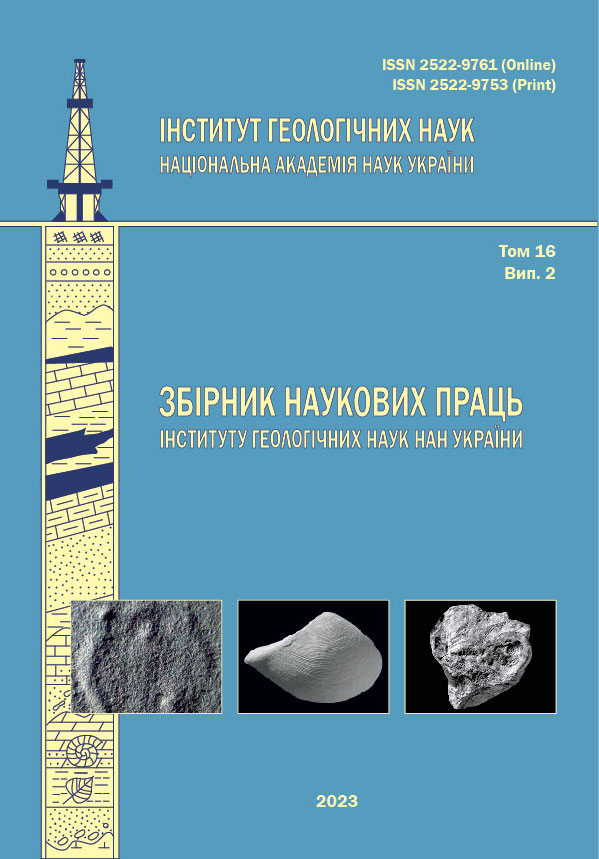НАЙДАВНІШІ CNIDARIA В ЕКОСИСТЕМІ ВОЛИНО-ПОДІЛЬСЬКОГО СЕДИМЕНТАЦІЙНОГО БАСЕЙНУ НА МЕЖІ ПРОТЕРОЗОЮ І ПАЛЕОЗОЮ
DOI:
https://doi.org/10.30836/igs.2522-9753.2023.292616Ключові слова:
едіакарій, венд, Поділля, кнідарії, медузи, поліпиАнотація
У відкладах верхнього едіакарію на Поділлі автором зібрано велику кількість скам’янілостей, які не мають систематичного опису. Морфологія і палеоекологія частина цих скам’янілих решток свідчить про їх ймовірну приналежність найдавнішим пелагічним медузам (Medusozoa), поліпам групи морських анемонів (Anthozoa) та предкам вимерлих в кінці палеозою Sphenothallus (Conulariida). Такий комплекс біотичних решток у відкладах едіакарію виявлено вперше у світовій практиці. Відсутність аналогічних знахідок в інших регіонах дає підстави вважати Волино-Подільський седиментаційний басейн едіакарського періоду найважливішим центром спеціації (зародження та еволюції) основних груп Cnidaria. Вперше в історії палеонтологічних досліджень виявлено монотопний ряд скам’янілих решток, які ілюструють етапи метаморфоз найдавніших організмів, наближені до стадій онтогенезу сучасних пелагічних Scyphozoa (Medusozoa). Виходячи з того, що сучасні медузи та морські анемони є хижаками і немає жодних свідчень що вони мали предків з іншим способом існування, та на основі опублікованих даних молекулярних досліджень генома різних груп Cnidaria висунуто гіпотезу що в екосистемі Волино-Подільського седиментаційного басейну едіакарського періоду виявлено найдавніших представників хижацтва. Отримані результати суперечать поширеній точці зору про відсутність хижацтва в екосистемі неопротерозою.
Посилання
Velikanov V. A., Aseeva E. A., Fedonkin M. A., 1983. Vendian of Ukraine. Kyiv, Naukova Dumka, 162 p. (In Russian).
Gureyev Yu. A., 1987. Morphological analysis and taxonomy of Vendiata. Kyiv, Institute of Geological Sciences of NAS of Ukraine. 54 p. (In Russian).
Ivantsov A. Yu., Gritsenko V. P., Paliy V. A., Velikanov V. A., Konstantinenko L. I., Menasova A. Sh., Fedonkin M. A., Zakrevskaya E. A., Serezhnikova E. A., 2015. Upper Vendian macrofossils of Eastern Europe. Middle Dniester area and Volhynia. Moscow, PIN RAS. 144 p. (In Russian).
Martyshyn A. I., 2022. The association of benthic macrobiota of the Late Ediacaran of Podillia in the deposits of the Mohyliv Podilskyi Group in the quarry near the Dniester HPP. Collection of scientific works of the Institute of Geological Sciences of NAS of Ukraine, vol. 15, Issue. 1. Pp. 44–64. https://doi.org/10.30836/igs.2522-9753.268218.
Paliy V. M., 1969. On a new species of Cyclomedusa from the Vendian of Podolia. Paleontologicheskiy Sbornik, No. 6, Issue.1, pp. 110–113. (In Russian).
Paliy V. M., 1976. Remains of non-skeletal fauna and traces of vital activity from deposits of the Upper Precambrian and Lower Cambrian of Podolia. In: Paleontology and stratigraphy of the Upper Precambrian and Lower Paleozoic of the southwest of the East European Platform (Ed. Shulga P. L.). Kyiv, Naukova Dumka. Pp. 63–77. (In Russian).
Ryabenko V. A., Velikanov V. A., Aseeva E. A., Paliy V. M., Tsegelnyuk P. D., Zernetskaya N. V., 1976. Paleontology and stratigraphy of the Upper Precambrian and Lower Paleozoic of the southwest of the East European Platform. Kyiv, Naukova Dumka, 168 p. (In Russian).
Gozhik P. F. (Ed.), 2013. Stratigraphy of the Upper Proterozoic and Phanerozoic of Ukraine. Kyiv, Logos, 637 p. (In Ukrainian).
Fedonkin M. A., 1981. White Sea Biota of Vendian. Precambrian Non-Skeletal Fauna of the Russian Platform North. Transactions of the Geological Institute, Academia of Sciences of the USSR. Vol. 342. Pp. 1–100.
Fuchs B., Wang W., Graspeuntner S., Li Y., Insua S., Herbst E.- M., Dirksen P., Bohm A.-M., Hemmrich G., Sommer F., Domazet Loso T., Klostermeier U. C., Anton-Erxleben F., Rosenstiel P., Bosch T. S. G., Khalturin K., 2014. Regulation of Polyp-to Jellyfish Transition in Aurelia aurita. Current Biology, vol. 24. Pp. 1–11. http://dx.doi.org/10.1016/j.cub.2013.12.003
Gehling J. G., Droser M. L., 2018. Ediacaran scavenging as a prelude to predation. Emerging Topics in Life Sciences. Pp. 1–11. https://doi.org/10.1042/ETLS20170166.
Gehling J. G., Narbonne G. M., Anderson M. M., 2000. The first named ediacarian body fossil: Aspidella terranovica. Palaeontology, vol. 43, part 3. Pp. 427–456.
Glaessner M. F., Daily B., 1959. The geology and late Precambrian fauna of the Ediacara fossil reserve. Records of the South Australian Museum, vol. XIII. Pp. 369–401.
Glaessner M. F., 1984. The dawn of animal life: a biohistorical study. Cambridge University Press, 244 p.
GrazhdankinD. V., 2014. Patterns of evolution of the Ediacaran soft-bodied biota. Journal of Paleontology, vol. 88(2) Pp. 269–283.
Han J., Hu Sh., Cartwright P., Zhao F., OuQ., Kubota Sh., Wang X., Yang X., 2016. The earliest pelagic jellyfish with rhopalia from Cambrian Chengjiang Lagerstätte. Palaeogeography, Palaeoclimatology, Palaeoecology, vol. 449. Pp. 166–173.
Hou, X.-G., Stanley G. D, Zhao, J., Ma, X.-Y., 2005. Cambrian anemones with preserved soft tissue from the Chengjiang biota, China. Lethaia, vol. 38. Pp. 193–203. ISSN 0024–1164.
Liu A. G., Matthews J.J., Menon L. R., McIlroy D., Brasier M. D., 2014. Haootia quadriformis n. gen., n. sp., interpreted as a muscular cnidarian impression from the Late Ediacaran period (approx. 560 Ma). Proc. R. Soc. B. 281. 20141202. http://dx.doi.org/10.1098/rspb.2014.1202.
MacGabhann B. A., 2007. Discoidal fossils of the Ediacaran biota: a review of current understanding. From: Vickers-Rich P., Komarower P. (eds) The Rise and Fall of the Ediacaran Biota. Geological Society, London, Special Publications. Pp. 297–313. DOI:110.1144/SP286.2.
Martyshyn A. I., 2023. Tymkivia primitiva gen. nov. sp. nov., a new type of fossils from the Late Ediacaran (Vendian) Kanylivka Group in Podolia, Ukraine. Geologičnij žurnal, vol. 2 (383). Pp. 58–67. https://doi.org/10.30836/ igs.1025-6814.2023.2.275044.
Martyshyn A., Uchman A., 2021. New Ediacaran fossils from the Ukraine, some with a putative tunicate relationship. Paläontologische Zeitschrift, vol. 95. Pp. 623–639. doi.org/10.1007/s12542-021-00596-1.
Menon L. R., McIlroy D., Brasier M. D., 2013. Evidence for Cnidaria-like behavior in ca. 560 Ma Ediacaran Aspidella. Geology, vol. 41, No 8. Pp. 1–4.
Mikulas R., Fatka O., 2017. Ichnogenus Astropolichnus in the Middle Cambrian of the Barrandian area, Czech Republic. Historical Biology, vol. 24(4). Pp. 1–8. https://doi.org/10.1080/10420940.2017.1292908.
Moon J., Caron J.-B., Moysiuk J., 2023. A macroscopic free swimming medusa from the middle Cambrian Burgess Sh Proc. R. Soc. B. 290: 20222490. https://doi.org/10.1098/rspb.2022.2490.
Muscente A. D., Shuhai X., 2015. New occurrences of Sphenothallus in the lower Cambrian of South China: Implications for its affinities and taphonomic demineralization of shelly fossils. Palaeogeography, Palaeoclimatology, Palaeoecology, vol. 437. Pp. 141–164. https://doi.org/10.1016/j.palaeo.2015.07.041.
Neal M. L., HannibalJ. T., 2000. Palaeocologic and taxonomic implication of Sphenothallus-like specimens from Ohio and areas Adjacent to Ohio. Journal of Paleontology, vol. 74(3). Pp. 369–380.
Nesterovsky V. A., Martyshyn A. I., Chupryna A. M., 2018. New biocenosis model of Vendian (Ediacaran) sedimentation basin of Podilia (Ukraine). Journ. Geology, Geography, Geoecology, No. 27 (1). Pp. 95–107. https://doi.org/10.15421/111835.
Park E., Hwang D.-S, Lee J.-S., Song J. I., Seo T.-K., Won Y.-J., 2012. Estimation of divergence times in cnidarian evolution based on mitochondrial protein-coding genes and the fossil record. Molecular Phylogenetics and Evolution, vol. 62. Pp. 329–345. https://doi:10.1016/j.ympev.2011.10.008.
Pemberton S. G., Frey R. W., Bromley R. G., 1988. The ichnotaxonomy of Conostichus and other plug-shaped ichnofossils. Can. J. Earth Sci, vol. 25. Pp. 866–892.
Seilacher A., 1990. Paleozoic trace fossils. In Said R. (ed.), The geology of Egypt. Balkema A. A. Rotterdam/ Brookfield. VT, Chapter 32. Pp. 649–722.
Soldatenko Y., el Albani A., Ruzina M., Fontaine C., Nesterovsky V., Paquette J.-L., Meunier A., Ovtcharova M., 2019. Precise U-Pb age constraints on the Ediacaran biota in Podolia, East European Platform, Ukraine. Nature Scientific Reports. Pp. 1–13. https://doi.org/10.1038/s41598-018-38448-9.
YoungG. A., Hagadorn J. W., 2010. The fossil record of cnidarian medusae. Palaeoworld, vol. 19. Pp. 212–221. Young G. A., Hagadorn J. W., 2020. Evolving preservation and facies distribution of fossil jellyfish: a slowly closing taphonomic window. Bollettino della Società Paleontologica Italiana, vol. 59 (3). Pp. 185–203. doi:10.4435/BSPI.2020.22.
Zhao Y., Parry L. A., Vinther J., Dunn F. S., Li Y.-J., Wei F., Hou X.-G. Cong P.-Y., 2021. An early Cambrian polyp reveals an anemone like ancestor for medusozoan cnidarians. Paleontology, vol. 66, part 1. DOI: 10.1111/pala.12637


